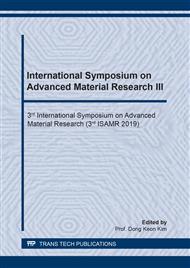[1]
A. Rajendran, G. Paredes, M. Mazzotti, Simulated moving bed chromatographyfor the separation of enantiomers, J. Chromatogr. A, 1216(4) (2009) 709-738.
DOI: 10.1016/j.chroma.2008.10.075
Google Scholar
[2]
M. Schulte, J. Strube, Preparative enantioseparation by simulated moving bedchromatography, J. Chromatogr. A, 906(1–2) (2001) 399-416.
DOI: 10.1016/s0021-9673(00)00956-0
Google Scholar
[3]
C. Y. Chin, N. L. Wang, Simulated moving bed equipment designs, Sep. Purif. Rev. 33(2) (2004) 77-155.
Google Scholar
[4]
P. M. S. Gomes, Advances in Simulated Moving Bed: New Operating Modes; NewDesign Methodologies; and Product (FlexSMB-LSRE) Development, FEUP, Porto, Portugal, (2009).
Google Scholar
[5]
V. M. T. Silva, M. Minceva, A. E. Rodrigues, Novel analytical solution for asimulated moving bed in the presence of mass-transfer resistance, Ind. Eng. Chem. Res. 43(16) (2004) 4494-4502.
DOI: 10.1021/ie030610i
Google Scholar
[6]
C. P. Le ao, A. E. Rodrigues, Transient and steady-state models for simulatedmoving bed processes: numerical solutions, Comput. Chem. Eng. 28(9) (2004) 1725-1741.
Google Scholar
[7]
K. U. Klatt, F. Hanisch, G. Dünnebier, Model-based control of a simulatedmoving bed chromatographic process for the separation of fructose andglucose, J. Process Control, 12(2) (2002) 203-219.
DOI: 10.1016/s0959-1524(01)00005-1
Google Scholar
[8]
G. Dünnebier, I. Weirich, K.-U. Klatt, Computationally efficient dynamicmodelling and simulation of simulated moving bed chromatographicprocesses with linear isotherms, Chem. Eng. Sci. 53(14) (1998) 2537-2546.
DOI: 10.1016/s0009-2509(98)00076-1
Google Scholar
[9]
P. Suvarov, A. Kienle, C. Nobre, G. D. Weireld, A. V. Wouwer, Cycle to cycleadaptive control of simulated moving bed chromatographic separationprocesses, J. Process Control, 24(2) (2014) 357-367.
DOI: 10.1016/j.jprocont.2013.11.001
Google Scholar
[10]
C. Grossmann, C. Langel, M. Mazzotti, M. Morbidelli, M. Morari, Multi-rateoptimizing control of simulated moving beds, J. Process Control, 20(4) (2010) 490-505.
DOI: 10.1016/j.jprocont.2009.12.001
Google Scholar
[11]
S. Abel, G. Erdem, M. Amanullah, M. Morari, M. Mazzotti, M. Morbidelli, Optimizing control of simulated moving beds – experimentalimplementation, J. Chromatogr. A, 1092(1) (2005) 2-16.
DOI: 10.1016/j.chroma.2005.04.101
Google Scholar
[12]
M. T. Liang, R. C. Liang, L. R. Huang, K. Y. Liang, Y. L. Chien, J. Y. Liao, Supercritical fluids as the desorbent for simulated moving bed – Application to the concentration of triterpenoids from Taiwanofugus camphorate, J. Taiwan Institute Chem. Engineers, 45(4) (2014) 1225-1232.
DOI: 10.1016/j.jtice.2013.10.013
Google Scholar
[13]
M. T. Liang, R. C. Liang, L. R. Huang, P. H. Hsu, Y. H. Wu, H. E. Yen, Separation of sesamin and sesamolin by a supercritical fluid-simulated moving bed, American J. Analytic. Chem. 3(12) (2012) 931-938.
DOI: 10.4236/ajac.2012.312a123
Google Scholar
[14]
M. T. Liang, R. C. Liang, L. Y. Wang, H. E. Yen, K. T. Lee, Effect of temperaturevariation on the separation of sesamin and sesamolin by simulated moving bed, J. Chem. Chem. Eng. 5 (2011) 479-486.
Google Scholar


